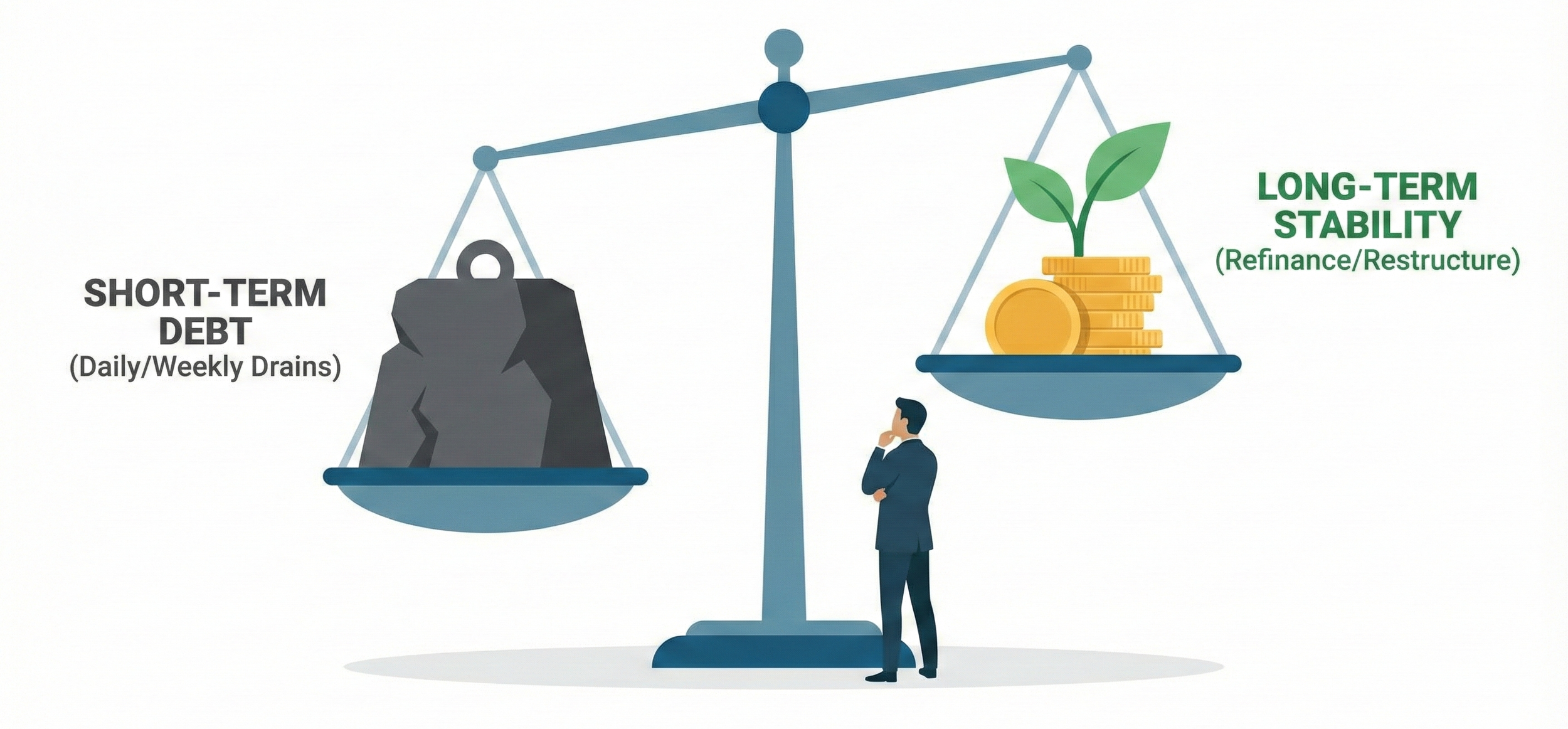10 Business Cash Flow Killers
Profit is vanity, Cash is sanity. This old business adage has never been more relevant.
As a small business owner, you’re likely obsessed with your profit and loss statement, celebrating the black ink at the bottom of the page.
But a profitable business can struggle with obtaining reasonable financing, keeping liquidity and operations can suffer as a result.
How? The answer lies in cash flow—the actual movement of money into and out of your business.
It is the oxygen that keeps your operations alive, allowing you to make payroll, pay suppliers, and invest in growth.
While a sudden crisis can certainly threaten your business, the more common and insidious threats are the silent killers—the slow leaks and unnoticed habits that drain your cash reserves over time.
These issues don't announce themselves with a bang; they creep in quietly, often disguised as normal business operations, until one day you’re staring at a bank balance that can’t cover next payroll or next month’s expenses.
Understanding and neutralizing these threats is not just good financial management; it is fundamental to survival and long-term success.
This article unmasks the ten most dangerous silent killers of cash flow and provides the strategies you need to protect the lifeblood of your business.
1. The Complacency of an Ignored Cash Flow Statement
For many business owners, financial reporting begins and ends with the income statement (or P&L) and the balance sheet.
The statement of cash flows is often treated as the forgotten third child, glanced at but rarely understood.
This is a catastrophic mistake.
The P&L, based on accrual accounting, shows revenues when they are earned and expenses when they are incurred, not when cash actually changes hands.
It (a P&L) can paint a rosy picture of profitability while your cash reserves are dwindling.
The cash flow statement, in contrast, is the ultimate source of truth about your liquidity.
It tells you exactly where your cash came from and where it went over a specific period, broken down into three critical areas: operations, investing and financing
Ignoring this document is like captaining a ship without a fuel gauge.
You might be making great speed, but you have no idea when you'll sputter to a halt.
To combat this complacency, you must make reviewing your cash flow statement a non-negotiable weekly or at least monthly habit.
Don't just look at the final number; dissect the components.
Is your cash from operations positive?
A healthy business should generate more cash than it consumes from its primary activities.
If it's consistently negative, it's a major red flag that your core business model is unsustainable without external funding.
Are you spending too much on investing activities, like new equipment, without a corresponding increase in operational cash flow?
Are you borrowing heavily (financing activities) just to cover operational shortfalls?
Regularly asking these questions transforms the cash flow statement from a confusing accounting document into your most powerful diagnostic tool, allowing you to spot negative trends long before they become full-blown crises.
2. The Slow Poison of Lagging Accounts Receivable
You made the sale.
You delivered the product or service.
You sent the invoice.
Congratulations on the revenue—but you can't pay your employees with revenue.
You pay them with cash.
The gap between booking a sale and collecting the money is your Accounts Receivable (A/R), and when managed poorly, it acts as a slow poison, methodically draining your business of its available cash.
Every dollar sitting in your A/R is a dollar you have earned but cannot use.
It’s an interest-free loan you are providing to your customers, and the longer they take to pay, the more it costs you in terms of lost opportunity and increased risk.
The problem often starts subtly. An invoice goes thirty days past due, then another.
Soon, a significant portion of your working capital is tied up in outstanding payments, forcing you to delay payments to your own suppliers, dip into your line of credit, or even miss payroll.
To counteract this poison, you need a proactive and systematic approach to collections.
This begins with clear and concise invoicing.
Ensure your invoices are sent immediately upon completion of work, are easy to understand, and clearly state the due date and the payment methods you accept.
Your payment terms should be firm.
While being flexible can feel like good customer service, terms like "Net 60" or "Net 90" can be devastating for a small business's cash cycle.
Aim for "Net 30" or less.
Consider offering a small discount, perhaps two percent, for payment within ten days.
This can incentivize prompt payment more effectively than late fees.
Furthermore, you must have a defined follow-up process.
Don't wait until an invoice is a month late.
Send a polite reminder a few days before the due date, another on the due date, and begin a more direct follow-up process the day it becomes overdue.
Automating these reminders through accounting software can save time and ensure consistency.
Finally, continuously monitor your A/R aging report.
This report categorizes your receivables by how long they’ve been outstanding.
If you see a trend of invoices moving into the "60-90 days past due" column, you have a systemic problem that needs immediate attention.
3. The Hidden Drain of Bloated Inventory
For businesses that sell physical products, inventory is a double-edged sword.
On one hand, you need enough stock to meet customer demand and avoid stockouts.
On the other, every item sitting on your shelves represents trapped cash.
Inventory is not a liquid asset; it is cash that has been converted into a physical good that you hope to sell in the future.
Excessive or obsolete inventory is a hidden drain that silently consumes your financial resources through a variety of costs.
There's the direct cost of purchasing the goods, but there are also significant carrying costs: storage and warehousing fees, insurance, security, potential spoilage or obsolescence, and the opportunity cost of the capital tied up that could have been used elsewhere.
This drain is particularly dangerous because it's not a line item on your income statement labeled "Wasted Cash on Excess Stock."
It’s hidden within your cost of goods sold and various overhead accounts.
Effectively managing inventory is about striking a delicate balance.
The key is to maximize sales while minimizing the amount of cash tied up in stock. Start by calculating your inventory turnover ratio.
This metric, calculated as
Inventory Turnover = Cost of Goods Sold / Average Inventory
and tells you how many times your company sells and replaces its inventory over a period.
A low turnover ratio suggests you are overstocking or that your products aren't selling well, indicating that cash is stagnating on your shelves.
A high ratio is generally better, but one that is too high might signal that you're understocking and missing out on potential sales.
Use this data to implement an inventory management system, whether it’s a simple spreadsheet or sophisticated software.
Employ forecasting techniques based on historical sales data and seasonal trends to make more accurate purchasing decisions.
Consider adopting a Just-In-Time (JIT) inventory strategy where possible, which involves ordering goods from suppliers only as they are needed for production or actual customer orders.
This minimizes holding costs but requires extremely reliable suppliers.
Regularly conduct physical inventory counts to identify slow-moving or obsolete items and then take decisive action—use promotions, sales, or bundling to convert that dead stock back into cash, even if it’s at a reduced margin.
It's better to recover some cash than none at all.
4. The Insidious Creep of Unchecked Overhead
Business expenses rarely arrive as a single, massive, unexpected bill.
Instead, they manifest as an insidious creep—a small subscription here, a slightly higher utility bill there, a new software tool that seemed essential at the time.
Individually, these costs may seem insignificant, but collectively they can form a major drain on your cash flow.
This phenomenon, often called "expense creep" or "cost creep," happens when operational overhead and other discretionary spending increase gradually over time without a corresponding increase in revenue or productivity.
It's the death-by-a-thousand-cuts for your bank account.
Because these expenses are often small and recurring, they fly under the radar, becoming accepted as the "cost of doing business."
The software subscription you signed up for but no longer use, the premium coffee service for the breakroom, the slightly-too-large office space—all these seemingly minor decisions slowly erode your cash position day by day.
Taming this beast requires discipline and a commitment to regular financial scrutiny.
The first step is to create a detailed budget or spending plan.
This isn't just a document you create once a year; it's a living tool you should compare against your actual spending on a monthly basis.
This process of budget-to-actual variance analysis will immediately highlight where you are overspending.
Scrutinize every single line item.
Ask the tough questions for each expense: Is this absolutely necessary for our operations?
Does this expense directly contribute to revenue generation or customer satisfaction?
Is there a more cost-effective alternative?
Be ruthless in this review.
Cancel unused subscriptions.
Renegotiate contracts with vendors and suppliers—everything from your phone service to your insurance provider.
You might be surprised at the savings you can achieve with a single phone call.
Encourage a cost-conscious culture throughout your entire organization.
When employees feel empowered to find efficiencies and are aware of the impact of spending, they become allies in the fight against expense creep.
This doesn't mean being cheap; it means being smart and intentional with every dollar that leaves your business, ensuring it serves a clear and valuable purpose.
5. The Deception of Confusing Profit with Cash
This is perhaps the most fundamental and misunderstood concept in small business finance, and it’s a killer.
You can have a record-breaking month in sales, leading to a beautiful profit figure on your income statement, yet find yourself unable to make payroll.
This paradox is the deception of confusing profit with cash.
The root of the confusion lies in accrual basis accounting, the standard method used to prepare most financial statements.
Under this method, revenue is recognized when it is earned, not when the cash is received.
Similarly, expenses are recognized when they are incurred, not when they are paid.
For example, if you complete a large project for a client in March and send an invoice for fifty thousand dollars, your income statement for March will show that revenue, boosting your profit.
However, if the client doesn't pay that invoice until May, you have zero cash from that transaction in March and April.
In the meantime, you still have to pay rent, salaries, and suppliers with real cash.
To avoid this trap, you must operate your business with a dual focus, constantly looking at both your P&L and your cash flow statement.
Think of profit as a theoretical measure of your business's performance over a period, while cash is the real-world fuel you need for daily survival.
One of the most effective tools to bridge this gap is a cash flow forecast.
This is a forward-looking projection of the cash you expect to come in and go out over the next few weeks and months.
It's not an accounting report of what has happened; it's an operational plan for what you expect to happen.
Your forecast should include anticipated cash receipts (when you actually expect customers to pay their invoices) and all anticipated cash disbursements (payroll, rent, supplier payments, loan payments, taxes).
By building and maintaining a rolling thirteen-week cash flow forecast, you gain incredible foresight.
You can anticipate cash shortfalls weeks in advance, giving you time to act—by chasing overdue invoices more aggressively, negotiating a delayed payment with a supplier, or drawing on a line of credit proactively rather than in a last-minute panic.
This foresight transforms you from a reactive victim of your cash cycle to a proactive manager of your liquidity.
6. The Trap of Unfavorable Payment Terms
In the complex dance of commerce, payment terms set the rhythm.
As a small business, you are often caught between two opposing forces: the payment terms you offer your customers (Accounts Receivable) and the terms your suppliers offer you (Accounts Payable).
The trap is set when you create or accept a significant mismatch between the two.
For example, you might feel pressured to offer your large corporate clients generous "Net 60" or "Net 90" payment terms to win their business.
Meanwhile, your own suppliers—for raw materials, rent, or utilities—may demand payment in "Net 30" or even "Cash on Delivery."
This creates a dangerous cash flow gap.
You are essentially funding your customers' operations for an extended period while being pressured to pay your own bills much more quickly.
This gap has to be filled with something, and that something is your cash.
The longer this gap persists, the more working capital is sucked out of your business, leaving you strained and vulnerable.
The solution lies in actively managing what's known as the Cash Conversion Cycle (CCC).
The CCC measures the number of days it takes for a dollar invested in inventory to make its way back into your bank account as cash.
A simplified view of the formula is:
CCC = Days of Inventory Outstanding + Days Sales Outstanding − Days Payables Outstanding
Your goal is to make this number as small as possible, or even negative.
To do this, you must attack all three components.
First, as discussed earlier, tighten your receivables by shortening customer payment terms and being diligent about collections.
Second, manage inventory efficiently to reduce how long it sits before being sold.
Third—and this is key—strategically negotiate your own payment terms with suppliers.
Don't passively accept their standard terms.
As a reliable and loyal customer, you have leverage.
Ask for "Net 45" or "Net 60."
By extending your own payment cycle (responsibly, of course), you are effectively using your supplier's capital to fund your operations for a longer period.
This alignment—getting paid by customers as quickly as possible while paying suppliers as slowly as is reasonably negotiated—narrows the cash flow gap and keeps more cash in your business, where it belongs.
7. The Peril of Revenue Concentration
Having a big, reliable client who accounts for a huge chunk of your revenue can feel like a blessing.
It provides stability, simplifies sales efforts, and can lead to predictable income.
However, this reliance is a hidden and extremely perilous threat to your cash flow and your business's very existence.
This is the danger of revenue concentration.
When one or two customers are responsible for a large percentage—say, more than twenty-five percent—of your total sales, you have effectively handed them control over your financial destiny.
What happens if this "whale" of a client suddenly goes out of business?
What if they are acquired by a company that uses a different vendor?
What if they decide to renegotiate their terms, demanding lower prices or extended payment schedules, knowing you can't afford to lose them?
Any of these scenarios can trigger an immediate and catastrophic cash flow crisis from which you may not recover.
The steady stream of cash you relied upon can vanish overnight, leaving you with fixed costs like rent and payroll that don't disappear with it.
Mitigating this risk requires a conscious and strategic effort to diversify your customer base.
This doesn't mean firing your best client.
It means you must actively work to reduce your dependence on them by building other revenue streams.
This process should be a strategic priority.
Allocate marketing and sales resources specifically to acquiring new customers in different industries or market segments.
If you primarily serve large corporations, develop an offering for small and medium-sized businesses. If your business is local, explore opportunities for regional or even e-commerce expansion.
Think about diversifying your product or service offerings as well.
Can you create complementary services or products that appeal to a different type of buyer?
The goal is to build a resilient business where the loss of any single customer would be a manageable setback, not an extinction-level event.
Spreading your revenue across a broader base of clients acts as a powerful insurance policy for your cash flow, ensuring stability and giving you the freedom to negotiate with all your clients—large and small—from a position of strength, not desperation.
8. The Temptation of Impulsive Capital Spending
Growth is exciting.
The thought of a bigger facility, brand-new machinery, or a fleet of shiny new vehicles can be incredibly tempting.
These capital expenditures (CapEx) feel like progress, a tangible sign that your business is succeeding.
However, making large capital investments impulsively, without rigorous cash flow analysis, is a classic trap that has sunk many otherwise healthy businesses.
The problem is that these major purchases require a significant upfront cash outlay (or commit you to long-term debt payments), and the return on that investment is often not realized for months or even years.
A new piece of manufacturing equipment might increase your production capacity, but if the additional sales don't materialize quickly, you are left with a massive cash drain and an underutilized asset.
You've traded your most flexible asset—cash—for a highly illiquid one.
This can starve your business of the working capital it needs for day-to-day operations, creating a cash crunch even as you're surrounded by impressive new assets.
Before committing to any significant capital expenditure, you must shift your mindset from "Can we afford this?" to "What is the cash-on-cash return, and how will this impact our liquidity?"
This requires a disciplined analytical approach.
First, perform a detailed cash flow projection that models the impact of the purchase.
How much cash is required upfront?
If you’re financing it, what will the exact monthly payments be, and for how long?
Crucially, you must then project the additional cash you realistically expect the investment to generate, and on what timeline.
Will the new machine reduce labor costs?
By how much, and when?
Will it allow you to produce more goods?
How confident are you that you can sell that additional output?
Calculate metrics like the Payback Period, which tells you how long it will take for the investment to generate enough cash to cover its own cost.
The formula is simply:
Payback Period = Annual Cash Inflow / Initial Investment
A shorter payback period is generally less risky.
Also consider alternatives.
Could you lease the equipment instead of buying it, preserving upfront cash?
Could you outsource that part of the production process?
The key is to separate the emotion of growth from the cold, hard logic of cash flow, ensuring that every major purchase is a strategic investment that strengthens your financial position, rather than a speculative gamble that jeopardizes it.
9. The Shadow of Poor Tax Planning
Taxes are one of the few certainties in business, yet many small business owners treat them as an afterthought.
They focus on running their business all year, and then scramble in the spring to figure out what they owe.
This reactive approach is incredibly dangerous for cash flow.
A surprisingly large tax bill that you haven't planned for can wipe out a significant portion of your cash reserves in an instant.
This "tax surprise" can force you to drain your operating accounts, take on expensive short-term debt, or even fall behind on payments to the government, leading to steep penalties and interest.
The government is your most unforgiving creditor.
Unlike a supplier, they won't accept a polite request for extended terms.
This silent killer lurks in the shadows all year, created by a lack of proactive planning, and strikes when you can least afford it.
The cash required for your tax liability is not your money; you are simply holding it in trust for the government.
Failing to recognize and set aside this cash is a critical error.
Effective tax planning is not about tax evasion; it's about smart, legal tax management that aligns your tax strategy with your cash flow realities throughout the year.
The cornerstone of this strategy is to stop thinking of taxes as a once-a-year event.
Work with a qualified accountant or tax advisor to create a projection of your tax liability for the upcoming year.
This allows you to make estimated tax payments quarterly, smoothing out the cash impact instead of facing one enormous bill.
This practice forces you to regularly set aside a portion of your income for your tax obligations.
Open a separate business savings account specifically for taxes.
Every time you receive a large payment from a customer, immediately transfer a calculated percentage of it into this tax account.
This discipline ensures the cash is there when the payment is due.
Furthermore, a good tax advisor can help you structure your business and your transactions in the most tax-efficient way possible.
They can advise you on when to make capital purchases to take advantage of depreciation rules like Section 179, help you maximize all eligible business deductions, and set up tax-advantaged retirement plans.
Proactive tax planning transforms taxes from a terrifying annual surprise into a predictable and manageable business expense, protecting your precious cash.
10. The Burden of Inefficient Debt Structure
Debt is a powerful tool.
Used wisely, it can provide the leverage needed to fuel growth, purchase critical assets, and manage temporary cash flow gaps.
However, used unwisely, or structured inefficiently, debt can become a crushing burden that suffocates your business.
An inefficient debt structure is a silent killer that works by locking you into high interest rates, unfavorable repayment terms, and a payment schedule that is misaligned with your business's cash flow cycle.
For example, many small businesses resort to using high-interest short-term financing, like merchant cash advances MCAs or personal credit cards, to cover long-term needs.
The exorbitant interest rates on this type of debt can create a vicious cycle, where a huge portion of your operational cash flow is diverted simply to service the interest, leaving little left for growth or even basic operations.
Another common mistake is using a short-term loan, with high monthly payments, to finance a long-term asset or for working capital.
The payment schedule drains cash much faster than the asset or the return on investment can generate it, putting immense pressure on your liquidity.
Optimizing your debt structure is a critical exercise in financial health.
Start by conducting a "debt audit."
Create a list of all your business debts, including the lender, outstanding balance, interest rate, monthly payment, and maturity date.
Your primary goal is to minimize your total cost of capital.
Are you paying twenty percent on a credit card balance when you might qualify for a bank line of credit at a much lower rate?
Look into debt consolidation or refinancing.
It may be possible to combine multiple high-interest loans into a single new loan with a lower interest rate and a more manageable monthly payment.
The most important principle is to match the term of the debt to the life of the asset or the purpose of the funds.
Use long-term loans for long-term assets like real estate or major equipment.
Use a revolving line of credit, which you can draw on and pay back as needed, for short-term working capital needs, like managing the gap in your receivables.
Don't be afraid to shop around for financing and negotiate terms with lenders.
A well-structured debt portfolio should feel like a strategic partnership that supports your business, not a heavy anchor that drags it down.
By actively managing your debt, you can significantly reduce your interest expense and free up vital cash flow each month.
WHAT IS THE BEST AND SAFEST WAY FOR YOUR BUSINESS TO DEAL WITH HIGH BUSINESS DEBT PAYMENTS?
It is NOT by stopping ACH payments.
It is NOT by taking on another business loan.
It is NOT ALWAYS a Refinancing
It is NOT by entering into a debt settlement program.
Find out the BEST strategies to get your Business back to where it was



















